Rating index:
Extraordinary (96-100)
Outstanding (93-95)
Very good to Excellent (89-92)
Above average to Good (86-88)
Below Average to Average (80-85)
Avoid (below 80)
More info >
Extraordinary (96-100)
Outstanding (93-95)
Very good to Excellent (89-92)
Above average to Good (86-88)
Below Average to Average (80-85)
Avoid (below 80)
More info >
Is there life without a water bath? For most modern top chefs, the answer would probably be a resounding "No". Sous vide cooking has become totally "de rigueur" in the last decade and in the hands of a competent chef the results of cooking food in the Roner (the state-of-the-art water bath with moving water and exact temperature control) are usually quite wonderful. The Roner was developed by Joan Roca and Narcís Caner (hence the name Ro-Ner) in 1997 and it has caused nothing less than a revolution in modern haute cuisine. For this reason alone, a visit to El Celler de Can Roca in Girona (Spain) is a pilgrimage for anyone seriously interested in gastronomy.
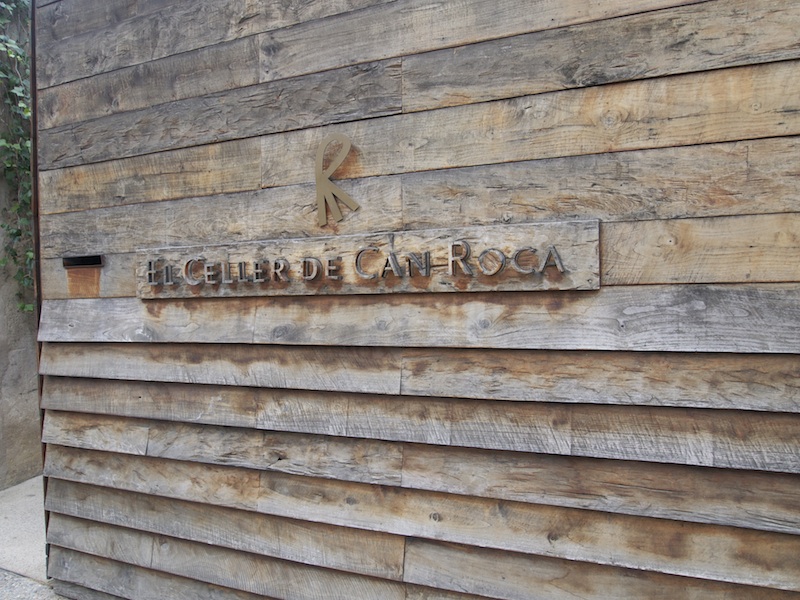
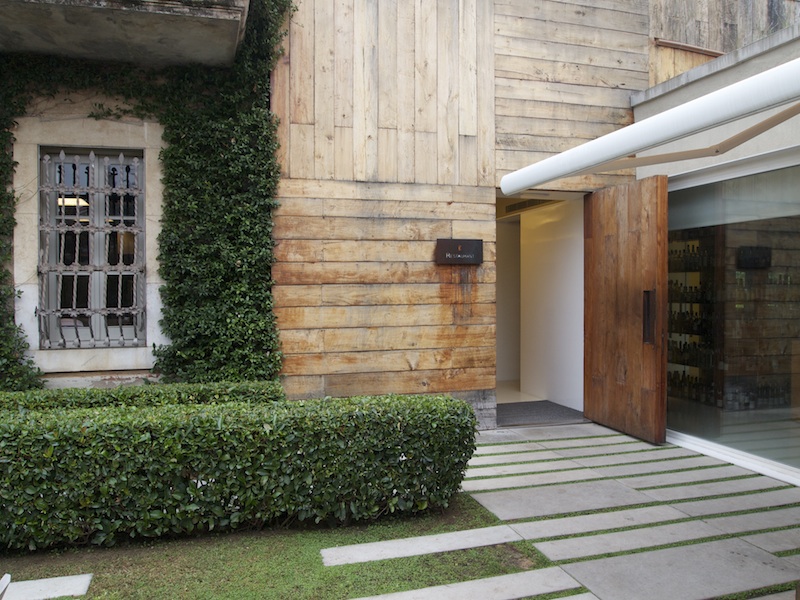
El Celler de Can Roca is the legendary restaurant of Joan (executive chef), Josep (head sommelier) and Jordi (pâtissier) Roca. When their parents opened Can Roca bar and restaurant in Girona in 1967, two of the Roca brothers had already been born (Joan in 1964 and Josep in 1966) but Jordi Roca was still resting in the lap of the future; he wasn't born until 1978. In 1986 Joan and Josep opened their own restaurant next to their parents' bar and named it El Celler de Can Roca. The rest is history of course, but please allow me to mention some highlights anyway.
The restaurant got its first Michelin star in 1995. Jordi Roca joined his brothers in the restaurant in 1997. In 2002 the restaurant gained a second star and in 2009, two years after the restaurant had relocated (some 100 metres up the road), the restaurant was awarded a third star. El Celler de Can Roca has also featured very prominently in "The World's 50 Best Restaurants" list (sponsored by San Pellegrino and Acqua Panna). In 2011 and 2012 El Celler de Can Roca took the number two spot in the list after Noma in Copenhagen. The restaurant entered the list in 2006 at number 21 and was promoted to the number 11 spot in 2007. For reasons unknown to anyone but the judges, Can Roca dropped to number 26 in 2008 before entering the top 10 in 2009 at number 5. After a pitstop at number 4 in 2010, the restaurant has been occupying the number 2 spot in the list.
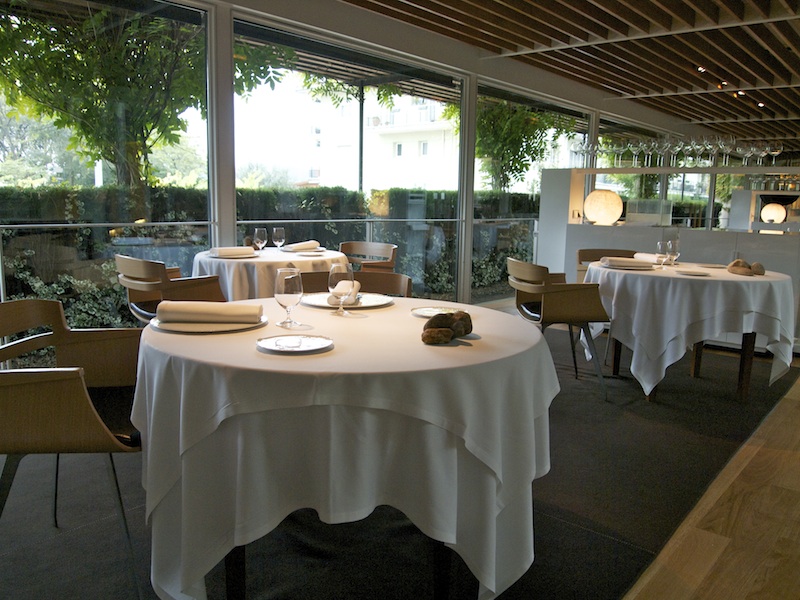
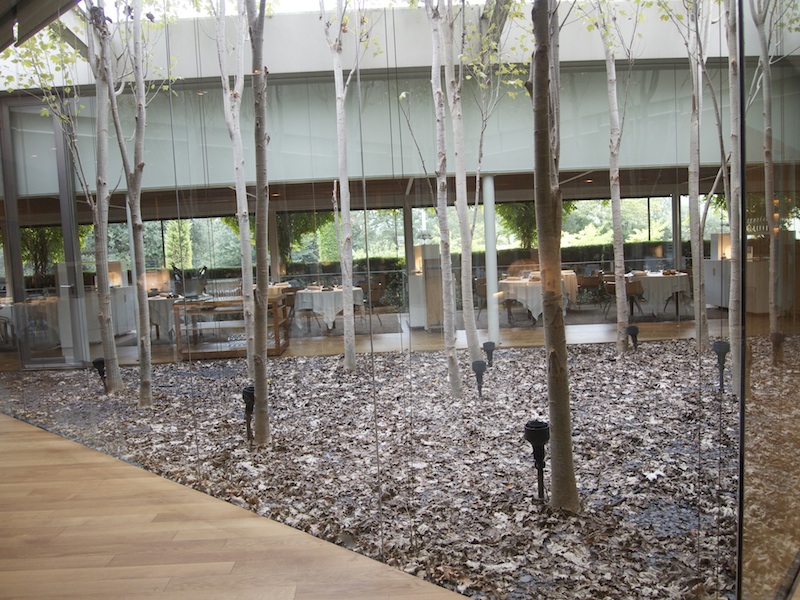
El Celler de Can Roca is open for lunch and dinner Tuesday till Saturday. The restaurant offers two tasting menus. There's the 6-course Classics menu for €135 and there's a 14-course Festival menu for €165. I had lunch with my husband at El Celler de Can Roca on 25 October 2012 and we both had the Festival menu. It was quite a ride.
First a paper globe was placed on the table. Hidden is this globe were 5 appetizers inspired by Joan Roca's travels to Japan, Morocco, Thailand, Peru and Mexico with each appetizer representing a flavour typical for that particular country. Clockwise, starting at the top: guacamole and grapefruit representing Mexico, warm spices representing Morocco, soy and wasabi representing Japan, ceviche and lime representing Peru and curry representing Thailand. Fun and delicious.
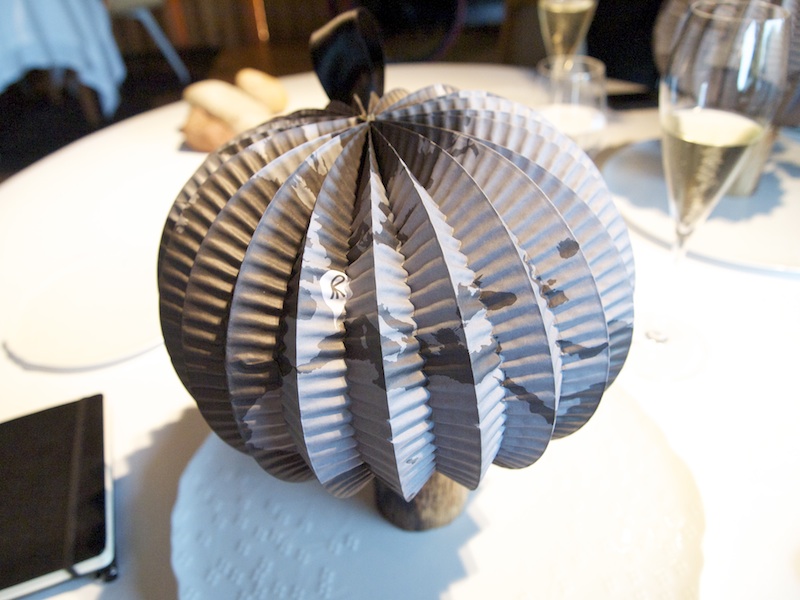
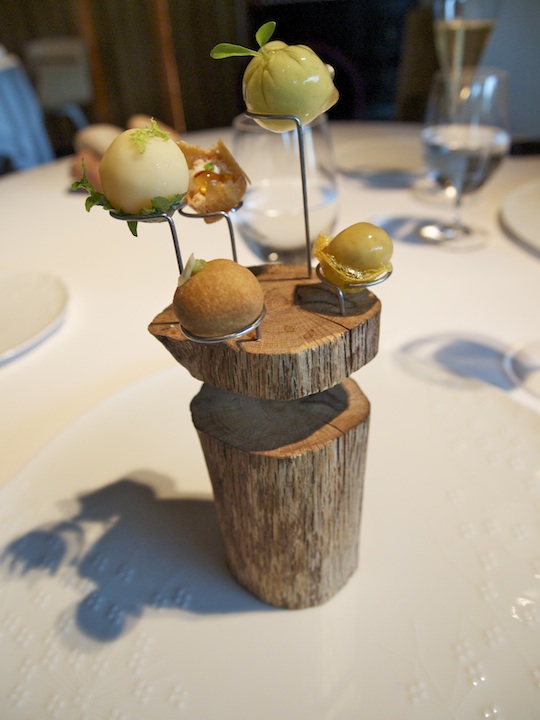
Next a Can Roca classic: an olive tree with caramelised olives in it. Lovely juicy olives with an anchovy filling and covered in nice, crunchy and sticky, caramel.
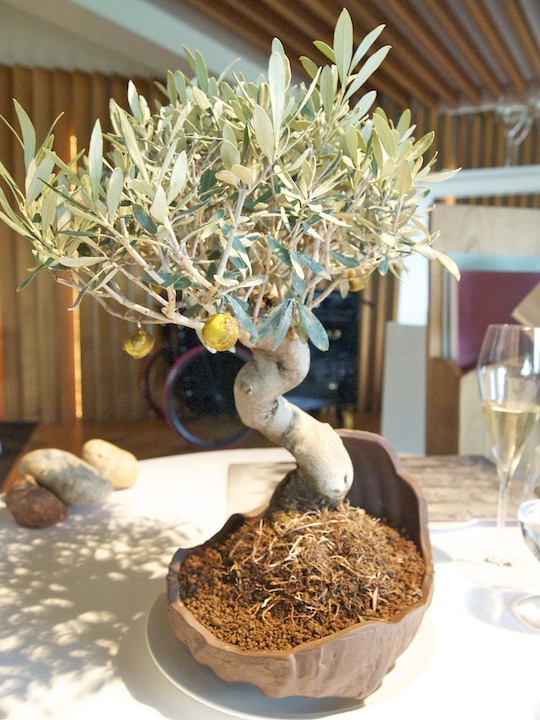
This was followed by four more appetizers:
1. Campari and grapefruit bonbon. A beautifully made bonbon with a gorgeous liquid filling that had very elegant bitters. The perfectly thin and crunchy casing was made with cocoa butter.
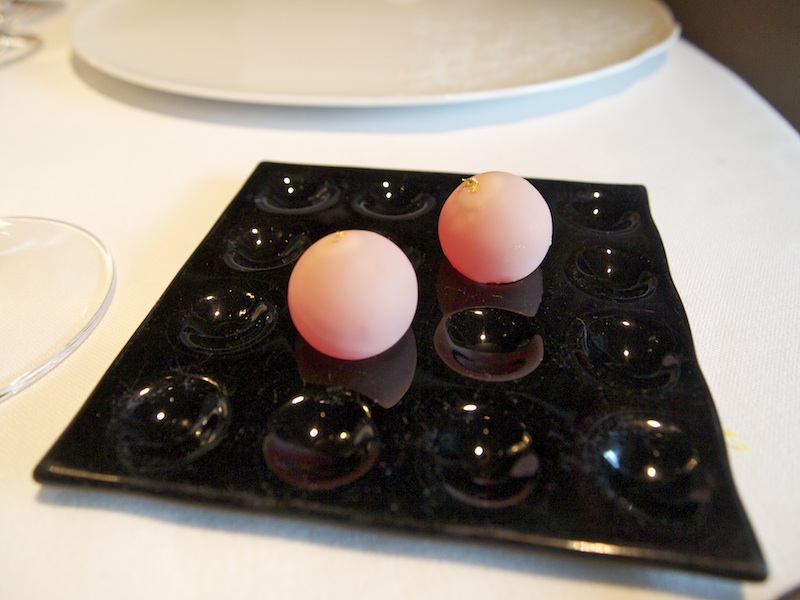
2. Calamares a la Romana (fried squid) or rather Can Roca's take on this Spanish classic. The calamari is turned into a calamari paste and then reshaped into nuggets, grilled with a blowtorch and topped with lemon crispies. The calamari was very intense but balanced beautifully by the lemon.
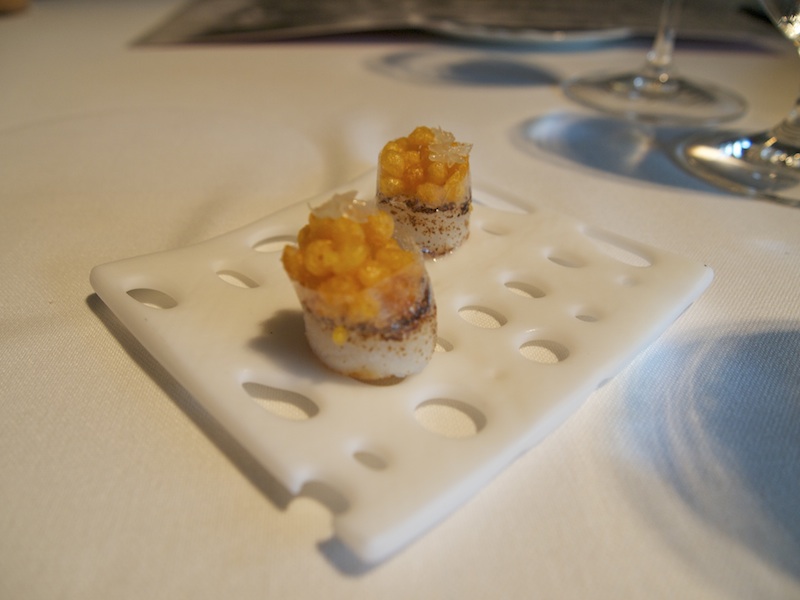
3. Marinated mussel, ceviche style. Lovely soft mussel with nice, subtle lime notes.
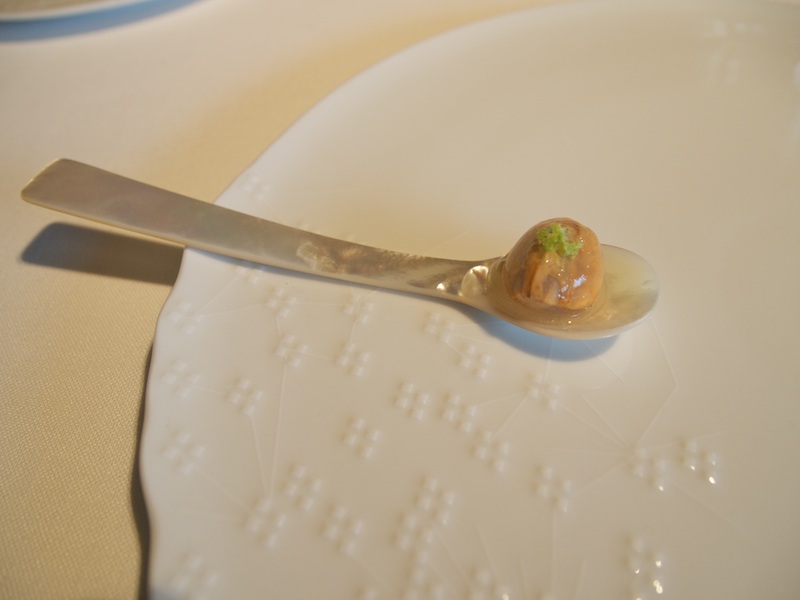
4. Truffle bonbon. A bonbon with the same cocoa butter casing as the Campari bonbon but this time dusted with black truffle powder and with a fantastic liquid black truffle filling. The truffle flavours were very pure and had a sensational aftertaste.
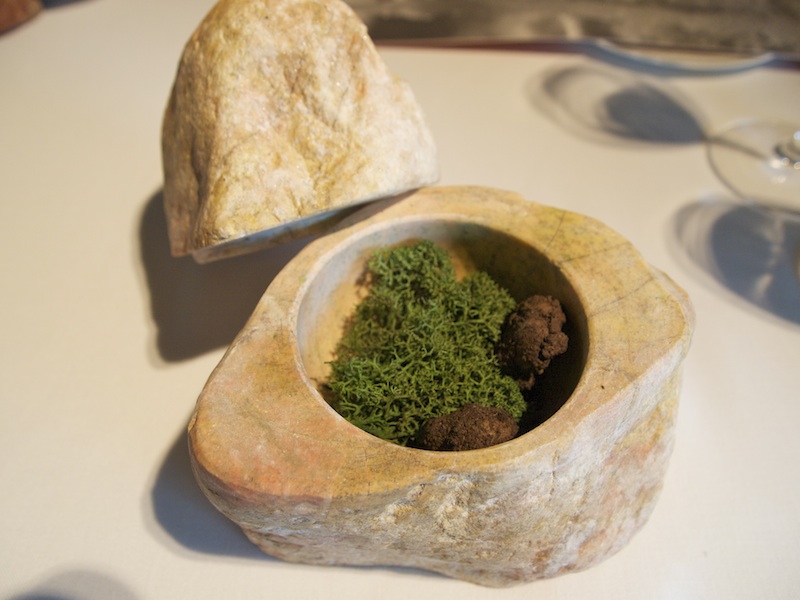
The final appetizer was Mushroom brioche. A moist brioche with a divine liquid ceps filling; so pure, so intense.
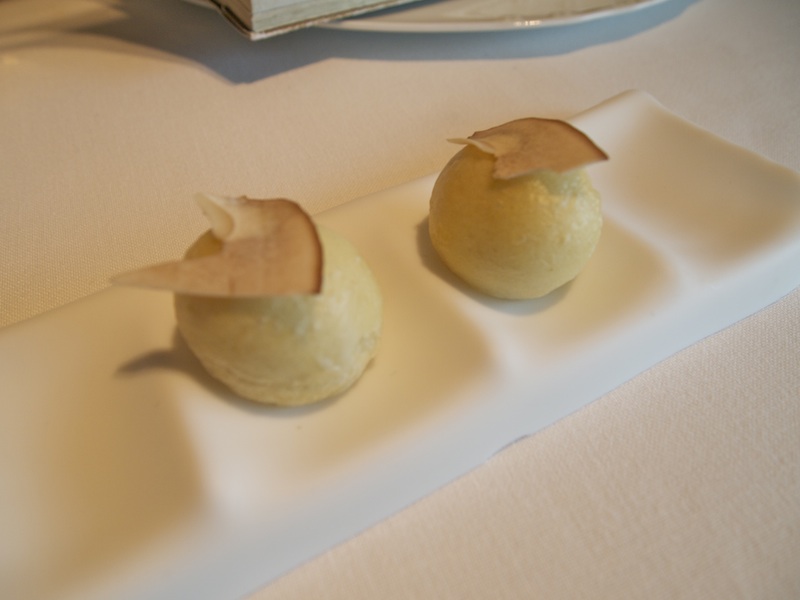
These adventurous appetizers really got the taste buds going as they were a feast for the senses. There was more to come.
The first course of the tasting menu was Green wheat, smoked sardine, grapes, toasted bread ice cream, olive oil, yeast foam. Incredibly pure garden-fresh liquid green wheat, that tasted 'green' and creamy at the same time and combined beautifully with the lightly smoked, small pieces of sardine. Nice sweetness from the grape jelly. Wonderful creamy toasted bread ice cream; the toasted bread flavours added a lovely touch of warmth. The yeast foam was a clever touch too and gave yet another dimension to this dish. A refined dish with multi-layered flavours and perfectly judged bitters.
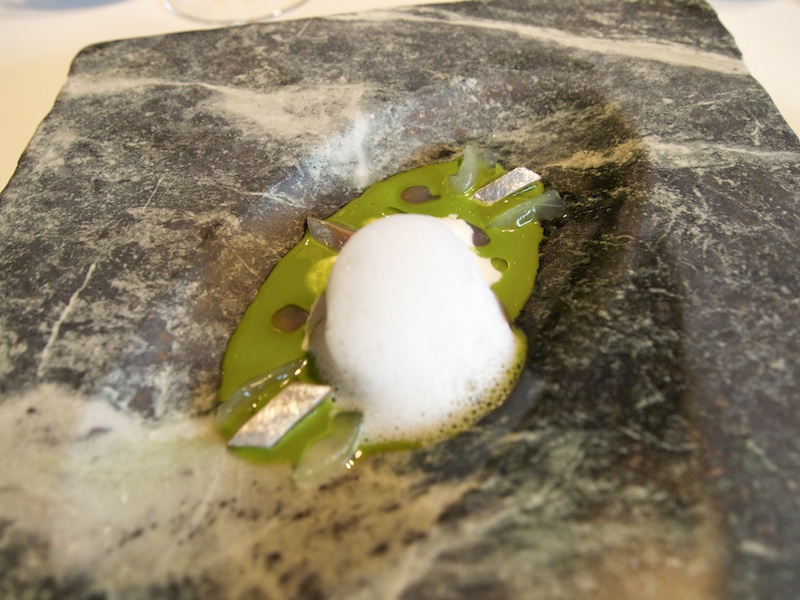
Second course was White asparagus and black truffle 'Comtessa'. An white asparagus dish made to look like Viennetta ice cream (or Comtessa as it's called in Spain). Creamy white asparagus parfait served with black truffle powder. The parfait had a wonderful velvety consistency and the intensity of the asparagus flavours was extraordinary, a true essence of asparagus.

On to the third course: Oysters Yin and Yang: fresh oysters, Palo Cortado sherry, white and black garlic. Two juicy oysters lightly coated with Palo Cortado sherry, one lukewarm, one cold. The cold oyster was served with a fantastic black garlic sauce and a few white garlic ice cream spheres. The lukewarm oyster came with a sublime white oyster sauce made with the oyster juices. An amazing dish with complex and well-balanced flavours. Lovely light garlic flavours, a hint of almond provided by the sherry and fantastic pure and fresh oyster flavours. Beautiful presentation too.

Next up, the fourth course: Black olive gazpacho, Picual olive paste, black olive fritter, Manzanilla olive ice cream, olive jelly, toasted bread, fennel jelly. Gorgeous gazpacho with wonderful, intricate olive flavours; very elegant, very balanced. The fantastic green olive (Mazanilla) ice cream was juicy and intense. The olive fritter was nice and oily. Also on the plate were a few small pieces of anchovy which added depth of flavour and a touch of saltiness. A dish with great textures and stunning, characteristic olive flavours that kept revolving in my mouth. Beautiful, intense and precise black olive flavour, mild, briny Manzanilla olive flavours and wonderful depth from the olive jelly.
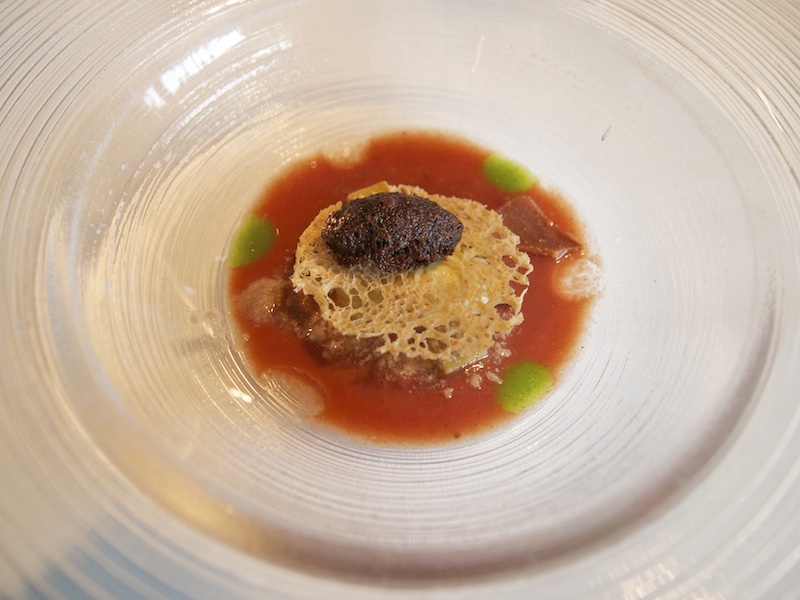
Fifth course. King prawn, squid ink rock, fried prawn legs, prawn essence, prawn head. 'Nose to Tail' king prawn style. Terrific juicy prawns with very subtle charcoal flavours accompanied by a divine thick and creamy bisque-like sauce. The squid ink rock had a moist cake-like consistency and was topped with delicious crispy and salty deep-fried prawn legs. Lovely, concentrated prawn flavours from the prawn and seaweed 'sand'. A truly brilliant dish with marvellous layers of prawn and marine flavours.
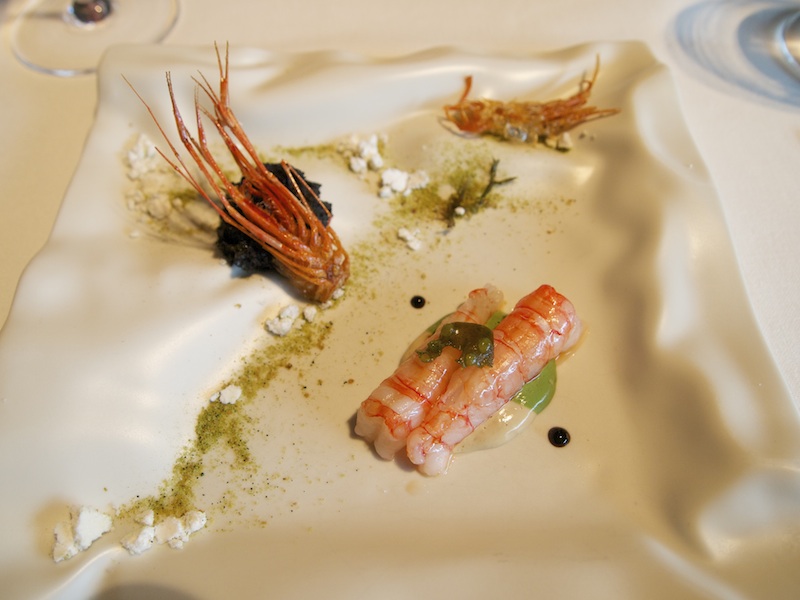
Sixth course. Red sea bream, yuzu, capers. A tender piece of well-cooked sea bream served with a selection of quite sour but crunchy, pickled vegetables. The capers combined well with the other ingredients. In fact it was essential to combine all ingredients to properly experience this dish.
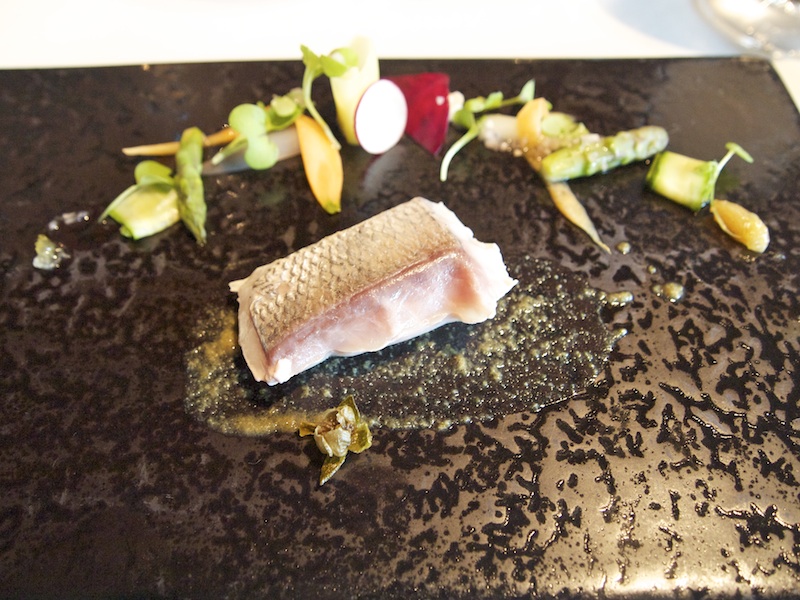
Seventh course. Salt cod brandade, olive oil and brandade soup, brandade foam, celery, shallots. Perfectly made salt cod brandade with a touch of chilli, accompanied by a delicious rich and silky-smooth olive oil and bradade soup and a wonderfully creamy brandade foam. The chilli added a nice touch of smokiness to the dish and each brandade version provided its own flavour intensity. A wonderful dish with a fabulous interplay of flavours and textures.
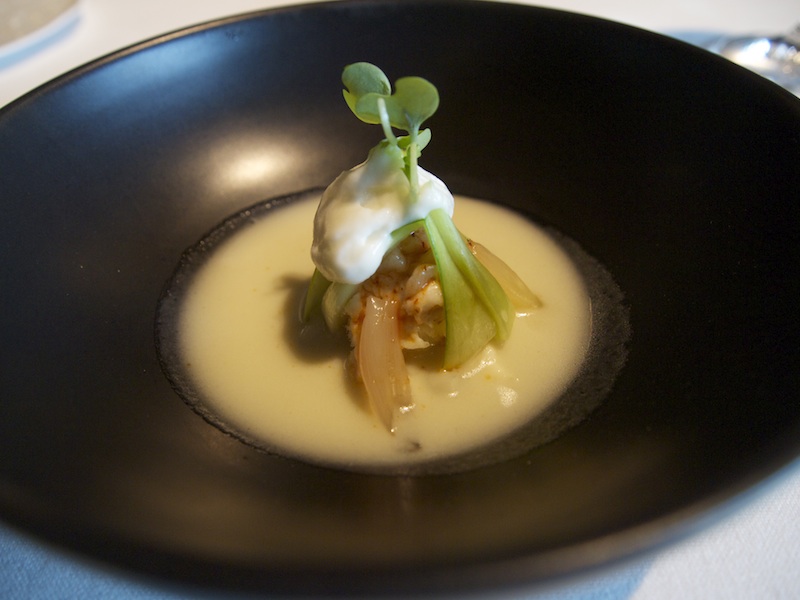
Eight course. Iberian suckling pig (loin), blanquette with Riesling, mango terrine, melon, beetroot black garlic, onion and orange concentrate.
Superb soft and tender pork (cooked at 63°C for 32 hours) with fantastic pieces of crisp crackling on top. Gorgeous creamy blanquette sauce, made with the pork stock and Riesling. To represent the deconstructed aromas that are typical for Riesling wine (or so I was told), there were two small cubes of mango terrine, concentrated orange and a small cube of melon marinated in beetroot juices. The orange delivered the perfect hint of tanginess, just as the mango provided sweetness. A sensational dish with masterfully engineered and beautifully balanced sweet flavours. With this dish we were served a glass of Forster Pechstein Riesling GC 2007 from Weingut Dr. Bürklin-Wolf, which obviously was a perfect match. This really is taking food and wine pairing to the next level.

Ninth course. Red mullet, shredded cabbage, orange, fennel and saffron puree. Red mullet with the tail still attached, cooked sous-vide and then finished under a Salamander, which results in very tender and pure red mullet. The red mullet was served with a stunning, powerful red mullet jus. The orange, fennel and saffron purees were lovely, especially the fragrant saffron one.
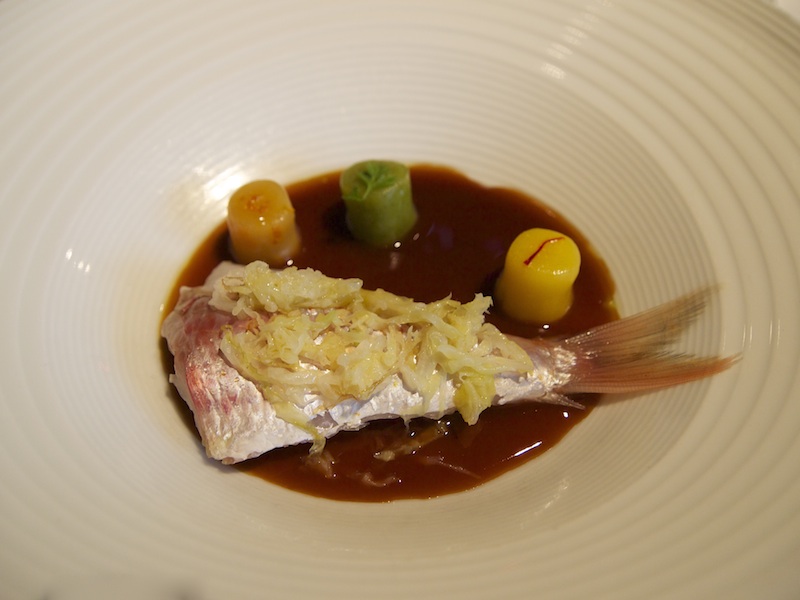
On the the tenth course: Lamb breast, sweetbreads, aubergine, coffee, liquorice. This dish arrived under a glass cloche filled with smoke. When the cloche was lifted, it revealed a lovely tender square of lamb breast and lamb sweetbread served with some crispy lamb skin, wonderful smoky aubergine and a beautiful concentrated lamb jus which really brought the dish together. Very well-judged use of both the coffee and liquorice. Loved the subtle bitters from the coffee.

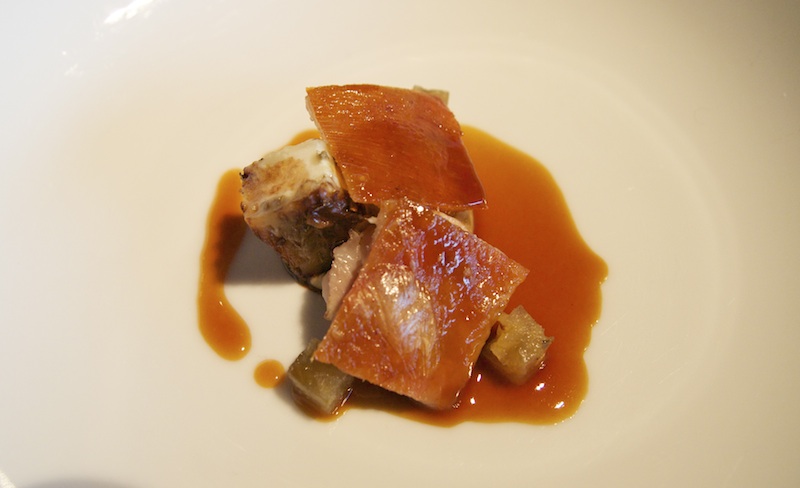
Eleventh course. Pigeon (breast and liver), onion, curried and caramelised walnuts, juniper, orange peel and herbs. This dish was more about the pigeon liver than the breast. At the bottom of the bowl there was a layer of divine, smooth and creamy, pigeon liver mousse topped by a gorgeous rich sauce with caramel-like flavours. Also in the bowl were different textures of onion and a 'bleu' sliver of pigeon breast. Great texture and flavour from the small pieces of curried and caramelised walnuts. A dish with clean and very precise flavours. The walnuts and orange peel added a magic touch to this dish.

Time for the desserts, first up (twelfth course) was Maple syrup, Guinness, pear, walnut and cardamom. Lovely light and delicate maple syrup cream, covered with an intensly flavoured Guinness jelly and accompanied by a delicious fresh pear and cardamom ice cream with wonderful warm cardamom flavours, finely chopped pear, caramelised walnut and small bonbons filled with pear liqueur. In a way a very clever and modern take on the classic Crema Catalana.
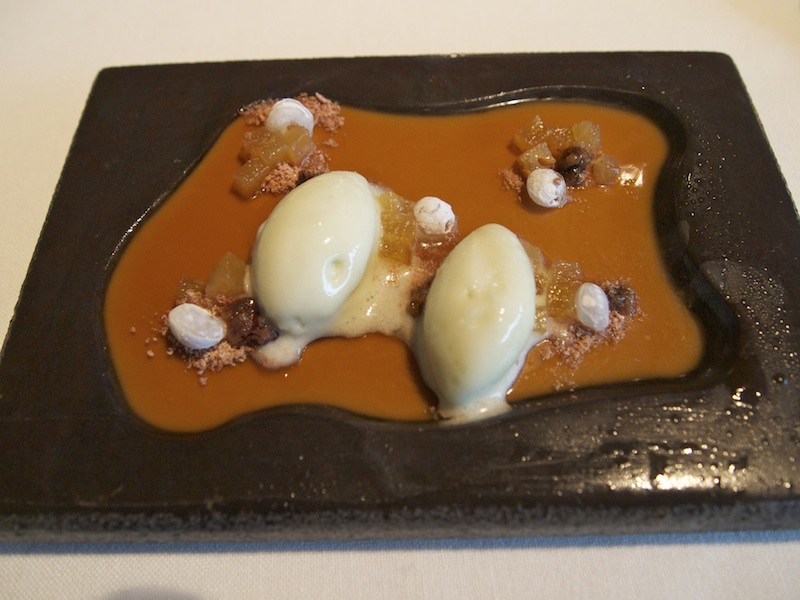
Second dessert (thirteenth course): 'Toffee apple', pomegranate candy floss, caramelised apple, caramel ice cream. The paper-thin blown-sugar apple was beautifully made and placed on top of some pomegranate candy floss. The apple was filled with a delicious, light and pure, apple foam. Underneath the apple foam there was a lovely light caramel ice cream and some nice and sticky caramelised apple and pomegranate.

Final dessert and fourteenth course: Mocha 'mille-feuille', vanilla ice cream, coffee granita. Fantastic crunchy sugar 'mille-feuille'. Between the crisp sugar sheets there were a light mocha foam, Madagascar vanilla ice cream and coffee granita. Also on the plate were some small cubes of coffee jelly and dots of dolce latte. The vanilla ice cream had very intense vanilla flavours; in fact the vanilla flavours were too strong for my liking. I like my vanilla ice cream a little creamier and less powerful.
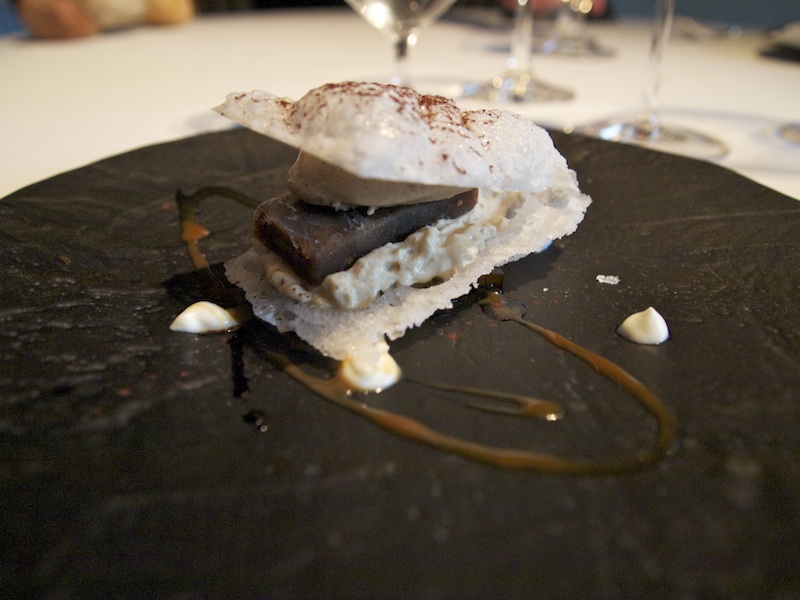
A selection of sweets, chocolates, macarons and marshmallows presented on the restaurant's dessert trolley designed by Andreu Carulla.

There is very little I can say that will add to the praise already heaped on El Celler de Can Roca by its many admirers of whom I have become one since my visit. The level of technical perfection that Can Roca achieves in its complex, elaborate dishes, equals (and perhaps even goes beyond) anything I have ever experienced in any other restaurant. The focus on the essence of the flavour of the main ingredient is truly exemplary and this provides the dishes with a rarely equalled precision and definition. The execution is flawless, the complexity is second to none, the cuisine is eclectic, the chef masterfully combines traditional and modern technique, the dishes are incredibly well thought out.
I was deeply impressed. Nothing is left to chance, neither on the plate nor in the restaurant. But was I perhaps more overawed than deeply moved? Did I experience respect rather than love? The very intellectual nature of the dishes occasionally made them come across as somewhat reserved, maybe even slightly haughty. The 14-course menu with matching wines was an incredible tour de force, an amazing display of inspiration, skill and expertise. It is almost to much to take in - in both senses of the word. The clientele is truly global, the experience is unique, the quest for perfection neverending. Virtuosity can be an ambiguous thing however; it can mesmerise but also make it difficult to connect.
In the final analysis however, does it matter? I leave it up to you. One thing is indisputable: El Celler de Can Roca is one of the finest restaurants in the world.













